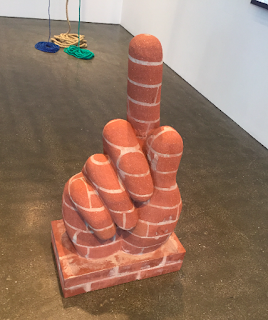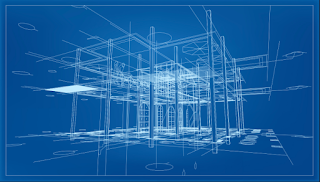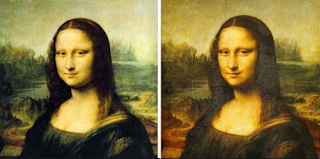Event 4- Judith Hopf
This exhibit was at the hammer
museum and was set up in a very interesting way. Like the Oleson exhibit it
just looked like the storage room where things were misplacing on the floor,
random wires coming out from the ground and ropes hanging from the ceiling. The
room had strange paintings on the walls, random sculptures made from brick on
the ground, a TV that played a video of a country field and ropes hanging from
the ceiling with the same ropes coming up from the ground across the room. Once
I read the banner explaining Hopf’s history as an artist, the structure and the
art itself made more sense.
(Courtesy of: Jordan Anderson) (Courtesy of: Jordan Anderson)
Hopf’s art
work always has a distinct sense of humor yet are challenging with a political
and economic underlying context. She loves to sculpt and her sculptures are
often made from simple materials you can find at a hardware store. In this
exhibit, most of her sculptures are made from brick. She was inspired to use
this material from a well-known minimalist sculptor Donald Judd who loved using
brick in his sculptures because of the “regular, repeating patter… the perfect
lines and flat surfaces…”. Her work, Ball
in Remembrance of Annette, is simply just a soccer ball sculpted from
brick. This is placed next to her piece Brick
Foot. This sculpture is exactly like it sounds; it is literally two feet sculpted
from brick. While this art piece may sound simple, the design and detail were
beautiful. It was uneven, had flat surfaces, some places had holes, just a
really well detail oriented foot. Across from the feet was a brick finger
titles Hand 1. Like the foot, this
was a very beautifully sculpted finger, but unlike the foot its was completely
smooth. It still had the lines on it like bricks have, but there were no holes
or unevenness about it. Diagonal in the room from the finger was a brick wagon and
next to the brick wagon was a bird looking sculpture. Both sculptures, like the
finger, where very smooth with no rough texture on them. I was really trying to
figure out how these related to each other until I read the sign and realized
that there is no connection. They were all her most recent sculptures, and she
just wanted to put them on display for us to see.
(Courtesy of: Jordan Anderson)
The sculptures
were the part of the exhibit that caught your eye because they were the first
things you saw when you walked in. they were also the objects on the ground you
had to walk around when you were in the room, so they were kind of the center piece
of the exhibit. They were not the only part of the exhibit though. If you went
towards the back of the room there were about 10 pictures of sculptures in funk
positions. The sculptures had a boxy shape to them, and they were all standing
a little sideways. If you looked closer you realized that the body of all the
sculptures were laptops. This collage was titles Waiting Laptops, and each of them had some character to them. Their
body position is shaped in a way that one might lay with a laptop on their lap.
When on lays on a couch they are kind of slumped and have, their laptops
resting on their laps. Hopf is suggesting that technology will change humanity in
more ways than one. It will change the way we sit, communicate, interact and
learn. She is also suggesting that this change will reach across a wide spread
of people, therefore the sculptures resemble many different types of people.
One resembles a cowboy, a fashionista, a toddler, a hipster and a business man.
This was the most interesting piece of art work in there because this shift is happening
in this class. Currently I am sitting on my couch in a slumped position writing
this blog, and technology is shifting the way I am learning and communicating
in this class.
(Courtesy of: Jordan Anderson) (Courtesy of: Jordan Anderson)
The last
part of this exhibit consisted of ropes hanging from the ceiling and the same
ropes coming out of the ground across the room. There was a tv with a video of
a farm, and out of nowhere a car would zoom by and make a sound so loud the
whole room would shake. There are usually sheep in her exhibit that fit in with
this art work called Flock of Sheep,
but they are currently in Italy with another art work of hers Birds Looking Back. Since the sheep are
not at in this exhibit she renamed it Up.
In the explanation, it said “the ropes were hung from the ceiling and pooled
onto the ground or appeared to jump out of the floor like snakes, enlivened and
reactive.” This is also how she wants you to feel when the peaceful film of the
farm land is interrupted by a car zooming by, creating a loud sound and causing
people in the room to jump and be reactive. What she is demonstrating with all
of this is nature is being interrupted with capitalism everyday causing things
to become unnatural. Therefore, she usually has sheep at this exhibit have expressionless
faces on. Society is forcing farms to sell out to nuclear power plants, big businesses
and construction. Hopf is trying to draw
attention to this issue and how disruptive it is not only to the animals, but
to the people who own that beautiful land.
(Courtesy of: Jordan Anderson) (Courtesy of: Jordan Anderson)
Hopf’s work
relates back to art, science and technology first off by how she creates the sculptures.
When sculpting any material, one must use precision and scientific technique to
make sure the surfaces are even and the weight is properly distributed. Hopf
uses technology to create her film of the farm, and then adjust the volume of
the speakers so the vibrations sake the room when the car zooms by. Her work in
her collage of sculptures, Waiting Laptops, she demonstrates the effect of technology
though art. She demonstrates in her art how technology is effecting the way
humans communicate, learn and even physically act. Technology is reaching
across many generations and many demographics, and the trend does not seem to
be slowing down. Almost all occupations use some sort of technology and
science, and artist are beginning to catch onto this trend. Almost every piece of
modern work I saw at the Hammer Museum combined science, art and technology. Artist
like Judith Hopf are using technology and science in their art work to talk
about the effects of science and technology, and I think this is a clever way
to get the word out and reach many areas.
(Courtesy of: Jordan Anderson)











Comments
Post a Comment